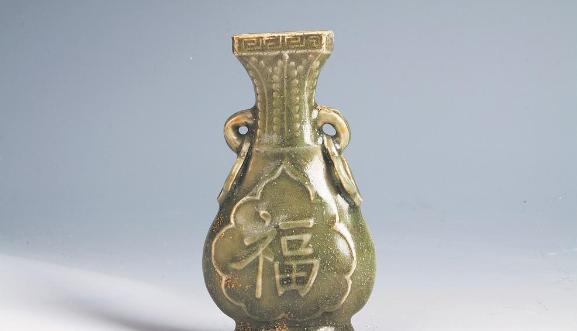
"Fu" porcelain
"Fu" word incense burner
As early as the Western Han Dynasty's Yuanguang to Yuanding (134-111 BC), the Minyue king Wuzhu established the "School Hunting Platform" and "Gaoping Garden" in Jiangle. During the first year of the Western Han Dynasty (140-134 BC), Yu Shan was a place of gongs and drums, bunting flags and hunting grounds to build the "LeYe Palace" as a leisure and blessing place for his song and dance hunting.
In the third year of the Three Kingdoms Wujing Emperor Sun Xiu Yong'an (260 AD), Hele was officially established as a county, which belonged to Jian'an County, because "Yi was in the sun of the Jiangxi River, Tu wo folk music" and "The Eastern Yue King Leye Palace was in it", named "Jiangle", becoming one of the few counties in the country where the name of the county has been unchanged since the establishment of the county.
The "blessing" of the music is embodied in the wuhua tianbao of this fertile land. Although the mountains and roads are dangerous, the Jinxi River, which has a flow of more than 90 kilometers in the territory, has been transported smoothly since ancient times. The ancestors of Jiangle along the coast began firing pottery during the Shang and Zhou dynasties. In the Jin Dynasty, it was possible to produce high-grade chicken head dragon handle pots and brown dot pots. By the Tang Dynasty, the Lelongchi Monument and Yan had become well-known in Eight Fujian. In the "Tang Sancai" exhibition area of the Xi'an History Museum in present-day Shaanxi Province, there is a "Distribution Map of Porcelain Kiln Ruins in the Tang Dynasty", which clearly marks more than 60 porcelain kiln sites across the country, and "Jiang le" is listed among them, indicating that the porcelain of Jiang Le has become famous in the Tang Dynasty.
In 2018, at the site of the Wanquan Bowl And Saucer Kiln upstream of the Jiangle Jin Creek, cultural relics workers archaeologically excavated the site of a Song Dynasty dragon kiln, which can demonstrate the development of the manufacturing industry of Jiangle porcelain at that time. Many porcelain excavated from here have the word "Fu" written prominently on the body, or decorated with bat patterns that imply "full of blessings". In January 2019, the "Happy Land Porcelain Rhyme" Fujian Jiangle Kiln Cultural Relics Exhibition was held at the Sackler Museum of Archaeology and Art of Peking University, exhibiting 133 pieces (sets) of complete ware from the Song to the Qing Dynasty and more than 200 specimens of the Jiangle kiln.
By the Song Dynasty, Jiangle had begun to min minerals such as gold, silver, copper, lead, iron, and limestone. By the Ming Dynasty, Jiangle had formed a commercial scale of six cities, five markets, and three meetings. It was also around this time period that the local Xishan paper handicraft began to mature. During the Qianlong period of the Qing Dynasty, Lexishan paper was listed as "official paper" for printing the "Four Libraries complete book".
Yang Shi, a famous scholar of science, said in the article "With Xu Gaolao" that the "blessed land" of Jiang Le is "the place where the five seasons avoid the land". He went around studying and lecturing or becoming an official, but the "blessed land" he most wanted to go to in his old age was his hometown of Jiangle, as he wrote in the article "Records of the Sacred Temple", which was expressed as follows: "Those who want to camp in the wilderness and have no easy hills for me, are the people of the past who are happy to live." ”
Today's Jiangle City and Countryside can make people feel a strong "blessing" atmosphere everywhere. Local folk proverbs like to use the metaphor of "blessing", "the tree hopes for the spring, the people look forward to the blessing", "the blessing is large, the amount is great", "the person does not know the blessing at home, the boat does not feel the flow in the river", "Life is blessed, plain and content", all these things, and so on.
There is a huge stone in front of Shifu Village in Anren Township, which the villagers affectionately call "Wufudun". From the front of Anren Cave, the streams flowing through Zefang and Wusu to Wan'an are named "Anfukou Creek" by the villagers. A wooden covered bridge in Shanfang Village, Dayuan Township was built in the Qing Dynasty, with heavy eaves and a mountaintop structure, sitting east to west, the bridge foundation stone masonry, single-hole stone arch bridge, the villagers call it "Yongfu Bridge". Located in Dayuan Xiyuan Village, a wooden arch outstretched arm flat girder bridge was built in the Qing Dynasty, the bridge foundation pebble masonry single hole, by three horizontal and three vertical sequentially stacked abutment, the bridge deck horizontally paved, exquisite construction, the villagers will call this wooden corridor bridge "Fuxing Bridge".
In the countryside of Jiangle, every household has a barn with a tile structure to store dried ingredients such as sesame seeds, flour, and rice. How do you label grains such as rice piled up in a barn? Clever Hakka ancestors invented the barn seal. After the autumn harvest, the grain enters the warehouse, and the villagers happily stamp the barn print on a pile of rice or a basket of sesame seeds and rice grains, one of which is for the sake of Tujili, and the other is to make a very practical anti-theft sign.
There is a large number of barn seals in the local collection, one of which is a woodcut square engraving with the word "Fu" on the back, and the back is a rice ear-shaped seal, full of people's hopes of a good harvest and good fortune. (Li Xuanhua text/photo)